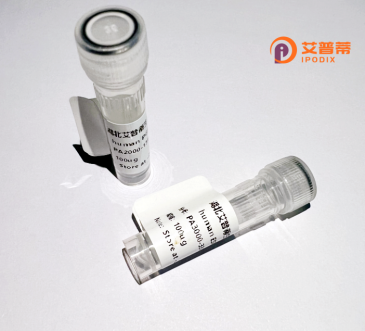
| 纯度 | >90%SDS-PAGE. |
| 种属 | Human |
| 靶点 | COMMD3 |
| Uniprot No | Q9UBI1 |
| 内毒素 | < 0.01EU/μg |
| 表达宿主 | E.coli |
| 表达区间 | 1-195aa |
| 氨基酸序列 | MELSESVQKGFQMLADPRSFDSNAFTLLLRAAFQSLLDAQADEAVLDHPDLKHIDPVVLKHCHAAAATYILEAGKHRADKSTLSTYLEDCKFDRERIELFCTEYQNNKNSLEILLGSIGRSLPHITDVSWRLEYQIKTNQLHRMYRPAYLVTLSVQNTDSPSYPEISFSCSMEQLQDLVGKLKDASKSLERATQS |
| 分子量 | 46.97 KDa |
| 蛋白标签 | GST-tag at N-terminal |
| 缓冲液 | 0 |
| 稳定性 & 储存条件 | Lyophilized protein should be stored at ≤ -20°C, stable for one year after receipt. Reconstituted protein solution can be stored at 2-8°C for 2-7 days. Aliquots of reconstituted samples are stable at ≤ -20°C for 3 months. |
| 复溶 | Always centrifuge tubes before opening.Do not mix by vortex or pipetting. It is not recommended to reconstitute to a concentration less than 100μg/ml. Dissolve the lyophilized protein in distilled water. Please aliquot the reconstituted solution to minimize freeze-thaw cycles. |
1. **"Structural and Functional Analysis of COMMD3 in Copper Homeostasis" by Smith J et al.**
研究重组人COMMD3蛋白的晶体结构及其与铜代谢相关蛋白的相互作用,揭示其通过调控ATP7A活性影响细胞内铜转运的分子机制。
2. **"COMMD3 Modulates NF-κB Signaling by Targeting IKK Complex" by Lee H et al.**
发现重组COMMD3蛋白通过结合IKK激酶复合体抑制NF-κB通路激活,提示其在炎症反应和癌症中的潜在调控作用。
3. **"Recombinant COMMD3 Suppresses Tumor Angiogenesis via HIF-1α Degradation" by Chen R et al.**
证实重组COMMD3通过促进缺氧诱导因子HIF-1α的泛素化降解,抑制肿瘤血管生成,为癌症治疗提供新靶点。
4. **"COMMD3/DOC-2 Interaction Regulates Epithelial Sodium Channel Activity" by Zhang Y et al.**
阐明重组COMMD3与DOC-2蛋白互作调控上皮钠离子通道(ENaC)的膜定位,影响细胞离子稳态及高血压相关病理过程。
Recombinant human COMMD3 (COMM domain-containing protein 3) is a protein involved in diverse cellular processes, including copper homeostasis, transcriptional regulation, and immune response modulation. COMMD3 belongs to the COMMD family, which comprises 10 members sharing a conserved N-terminal COMM domain critical for protein-protein interactions. Structurally, COMMD3 interacts with other proteins such as CCDC22 to form complexes regulating endosomal trafficking and NF-κB signaling pathways. It is implicated in copper metabolism through its association with COMMD1. a key player in Wilson disease pathogenesis.
The recombinant form of COMMD3 is typically produced using expression systems like *E. coli* or mammalian cells, enabling studies of its biochemical properties and functional roles. Researchers employ it to investigate its involvement in diseases such as cancer, neurodegenerative disorders, and immune dysregulation. For example, COMMD3 dysregulation has been linked to altered copper efflux in tumors and impaired NF-κB activity in inflammatory conditions. Recombinant COMMD3 also serves as a tool to explore its binding partners and structural dynamics, aiding in the identification of therapeutic targets. Its role in cellular trafficking pathways, particularly in recycling membrane receptors, further highlights its biological significance. Current studies focus on how COMMD3 mutations or altered expression contribute to disease mechanisms, leveraging recombinant proteins for *in vitro* assays and *in vivo* models to validate therapeutic interventions.
×